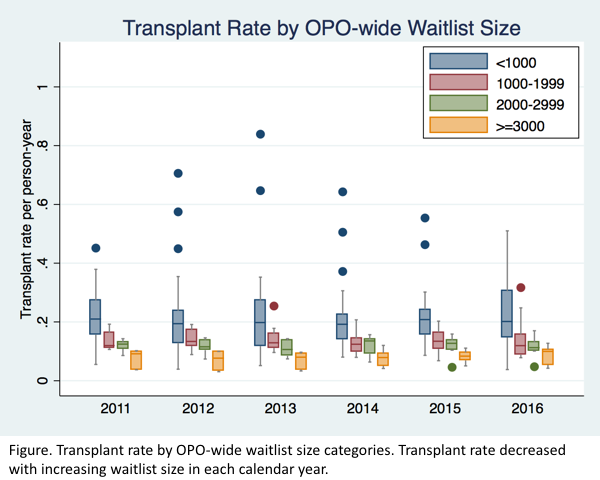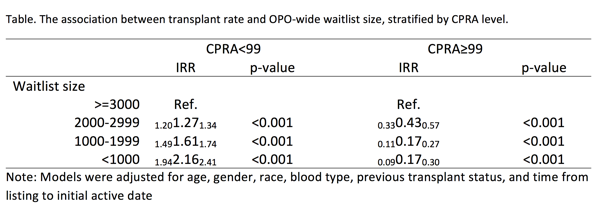OPO-Wide Waitlist Size and Deceased Donor Kidney Transplant Rate.
1JHU, Baltimore, MD
2USNA, Annapolis, MD
Meeting: 2017 American Transplant Congress
Abstract number: A93
Keywords: Kidney transplantation
Session Information
Session Name: Poster Session A: Deceased Donor Issues I: Allocation, KDPI and Recipient Selection
Session Type: Poster Session
Date: Saturday, April 29, 2017
Session Time: 5:30pm-7:30pm
 Presentation Time: 5:30pm-7:30pm
Presentation Time: 5:30pm-7:30pm
Location: Hall D1
Substantial geographic disparity exists in access to deceased donor kidney transplantation (DDKT); mechanisms for the disparity are not fully understood. The relationship between OPO-wide waitlist size and DDKT rate has not been described.
METHODS: We analyzed 268,178 adult, kidney-only registrants from 01/01/2011-03/01/2016 using SRTR data. We measured OPO-wide waitlist size as the total number of prevalent registrants on January 1st each year. We compared the transplant rate among waitlist size categories (<1000, 1000-1999, 2000-2999, ≥3000 registrants) using a multilevel Poisson regression adjusting for age, race, gender, blood type, CPRA, previous transplant, and time from listing to initial active date. We also tested potential interaction between CPRA and waitlist size.
RESULTS: The median OPO-wide waitlist size was 2,423 (IQR 1,326-4,333, range 67-8,319). OPO volume remained relatively constant over time (correlation for 2011 vs 2016 = 0.97). The crude transplant rate decreased with increasing waitlist size, and that trend stayed the same for each calendar year (Figure). Compared to transplant rates in OPOs with 3000 registrants or more, transplant rates in OPOs with 2000-2999 registrants were 19% higher (RR= 1.131.191.25, p<0.001), transplant rates in OPOs with 1000-1999 registrants were 40% higher (RR= 1.301.401.51, p<0.001), and transplant rates in OPOs with fewer than 1000 registrants was 81% higher (RR= 1.631.812.01, p<0.001). Among patients with CPRA≥99, the association between transplant rate and waitlist size was reversed (Table).
CONCLUSION: OPOs with large waitlists had lower transplant rates overall, but interestingly this effect was reversed for highly sensitized candidates. Policy changes that reduce geographic disparity in access to DDKT might benefit candidates in OPOs with both large and small waitlists.

CITATION INFORMATION: Zhou S, Massie A, Gentry S, Segev D. OPO-Wide Waitlist Size and Deceased Donor Kidney Transplant Rate. Am J Transplant. 2017;17 (suppl 3).
To cite this abstract in AMA style:
Zhou S, Massie A, Gentry S, Segev D. OPO-Wide Waitlist Size and Deceased Donor Kidney Transplant Rate. [abstract]. Am J Transplant. 2017; 17 (suppl 3). https://atcmeetingabstracts.com/abstract/opo-wide-waitlist-size-and-deceased-donor-kidney-transplant-rate/. Accessed December 28, 2025.« Back to 2017 American Transplant Congress
